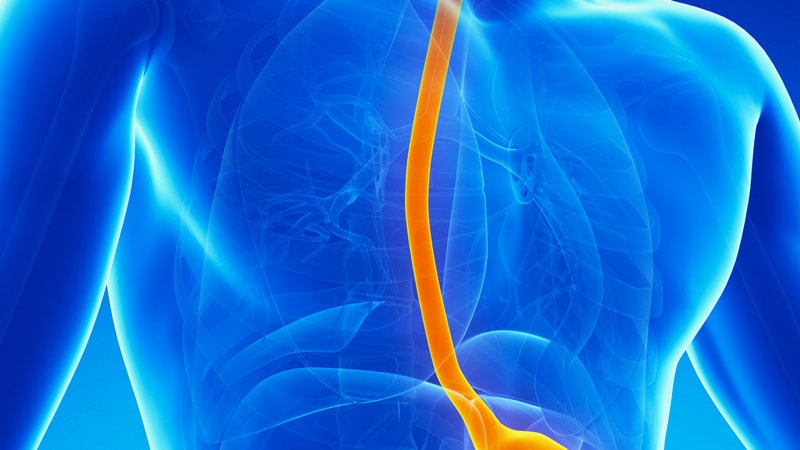New research suggests that body mass index (BMI) may influence response to topical corticosteroid (tCS) therapy for eosinophilic esophagitis (EoE).
The higher the patient’s BMI level, the lower the individual’s response to tCS therapy from a symptomatic, endoscopic, and histologic perspective, researchers observed in a retrospective study.
Because there are few clinical predictors of response to topical steroids, clinicians may want to consider BMI in their treatment algorithm and when discussing therapeutic treatment options with patients with EoE, the investigators write in an article published online in Clinical Gastroenterology and Hepatology.
For EoE, current guidelines recommend the use of proton-pump inhibitor (PPI) therapy, topical steroids, and dietary elimination. In addition, the biologic dupilumab (Dupixent) was recently approved in the United States for EoE.
Determining what therapy patients with EoE will respond best to remains a challenge, and obesity’s role in treatment response has been unclear.
To investigate the effect patients’ weight might have on tCS therapy, Evan Dellon, MD, MPH, and colleagues at the University of North Carolina School of Medicine in Chapel Hill reviewed cases involving 296 adults and adolescents aged 14 years and older who had received topical steroids for EoE.
Baseline characteristics were similar, although heartburn was more common among the 68 patients with obesity than among the non-obese patients (59% vs 37%; P = .001), and the rate of hiatal hernias detected endoscopically was higher among the patients with obesity (22% vs 11%; P = .02).
Following tCS treatment, peak eosinophil counts were higher for patients with obesity compared to non-obese patients (36.1 vs 21.5; P = .003).
Histologic response was significantly higher in non-obese patients compared to patients with obesity, at <15 eosinophils per high-power field (eos/hpf: 61% vs 47%; P = .049) and ≤ 6 eos/hpf (54% vs 38%; P = .02).
Among the non-obese patients with EoE, global endoscopic response to tCS was significantly greater than among the patients with obesity (76% vs 59%; P = .006).
In additon, among non-obese patients, the post-treatment EoE-Endoscopic Reference Score (2.4 vs 3.2; P = .01) and the endoscopic severity score were significantly lower (2.0 vs 2.4; P = .05).
Global symptomatic response to tCS was seen in 84% of non-obese patients, vs only 67% of those with obesity (P = .03).
On multivariate analysis, increasing BMI was independently associated with decreased histologic response after accounting for age, heartburn, dilation, and hiatal hernia.
This relationship persisted whether BMI was assessed as a continuous variable (adjusted odds ratio [aOR], 0.93 for each unit increase in BMI), as non-obese vs obese (aOR 0.38), or as overweight vs normal weight (aOR 0.46) or obese vs normal weight (aOR 0.26).
Different Treatment Algorithm?
The results remained generally similar when patients were stratified by PPI response status and by continued use of PPIs.
The investigators note that in their cohort, only five patients responded to PPI therapy; all were non-obese. It’s possible, they note, that patients with a higher BMI may benefit from dual PPI/tCS treatment initially, but this strategy would require prospective assessment.
As for the mechanism behind obesity’s apparent negative impact on tCS therapy, the researchers say the low-grade systemic inflammatory state of obesity may make tCS therapy less effective, but they add that studies are needed to pinpoint the exact mechanism.
The study suggests that “a clinician can now add another epidemiologic risk factor for potential poor response to treatment for EoE, specifically steroids,” Philip Katz, MD, professor of medicine, Division of Gastroenterology and Hepatology, Weill Cornell Medicine, New York City, told Medscape Medical News when reached for comment.
However, it is “difficult, if not impossible, to discern from a retrospective study like this why higher BMI would be a risk factor for poor response,” said Katz, who was not affiliated with the study.
“The main potential clinical message here is that people who are overweight with EoE perhaps need to be looked at differently and might require a different treatment algorithm or treatment approach than a person who is ideal body weight,” Katz added.
Also commenting to Medscape Medical News, Shreya Chablaney, MD, a gastroenterologist at NYU Langone Health’s Center for Esophageal Health and clinical instructor at NYU Grossman School of Medicine, noted that predictors of patient response to various treatment options for EoE are not well understood and that more robust data are needed to guide appropriate patient selection when considering them.
“Though this is a relatively small, single-center, retrospective study, it shows an interesting finding, that high BMI is independently associated with a decrease in histologic, symptomatic, and endoscopic response to topical steroids, even when controlling for heartburn and the presence of a hiatal hernia,” she said.
“While these findings may not yet affect current management, it highlights the need for more prospective research to see if dosing adjustment, type of topical steroid, or alternative therapy altogether should be considered in patients who are obese,” Chablaney said.
Support for the study was provided by the National Institutes of Health. Dellon is a consultant for Abbott, AbbVie, Adare/ Ellodi, Aimmune, Akesobio, ALK, Allakos, Amgen, Arena, Aslan, AstraZeneca, Avir, Biorasi, Calypso, Celgene/Receptos/BMS, Celldex, Eli Lilly, EsoCap, Eurpaxia, Ferring, GSK, Gossamer Bio, Invea, Landos, LucidDx, Morphic, Nutricia, Parexel/Calyx, Phathom, Regeneron, Revolo, Robarts/Alimentiv, Salix, Sanofi, Shire/Takeda, and Target RWE. Katz is a consultant for Phathom Pharmaceuticals and Sebella Pharmaceuticals and serves on an advisory board for AstraZeneca. Chablaney reports no relevant financial relationships.
Clin Gastro Hepatol. Published online November 18, 2022. Abstract
For more news, follow Medscape on Facebook, Twitter, Instagram, and YouTube.
Source: Read Full Article
